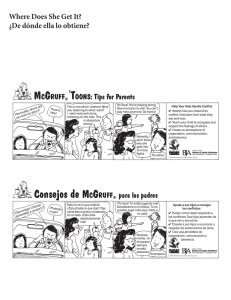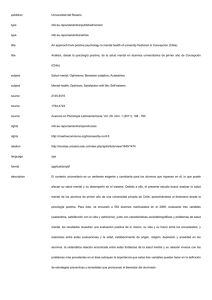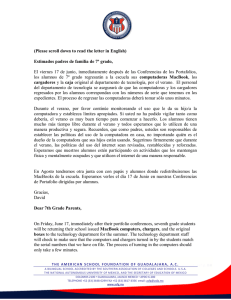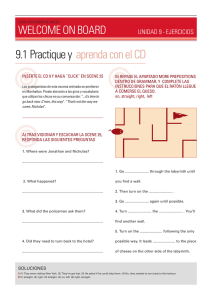Don`t Be an Alien
Anuncio
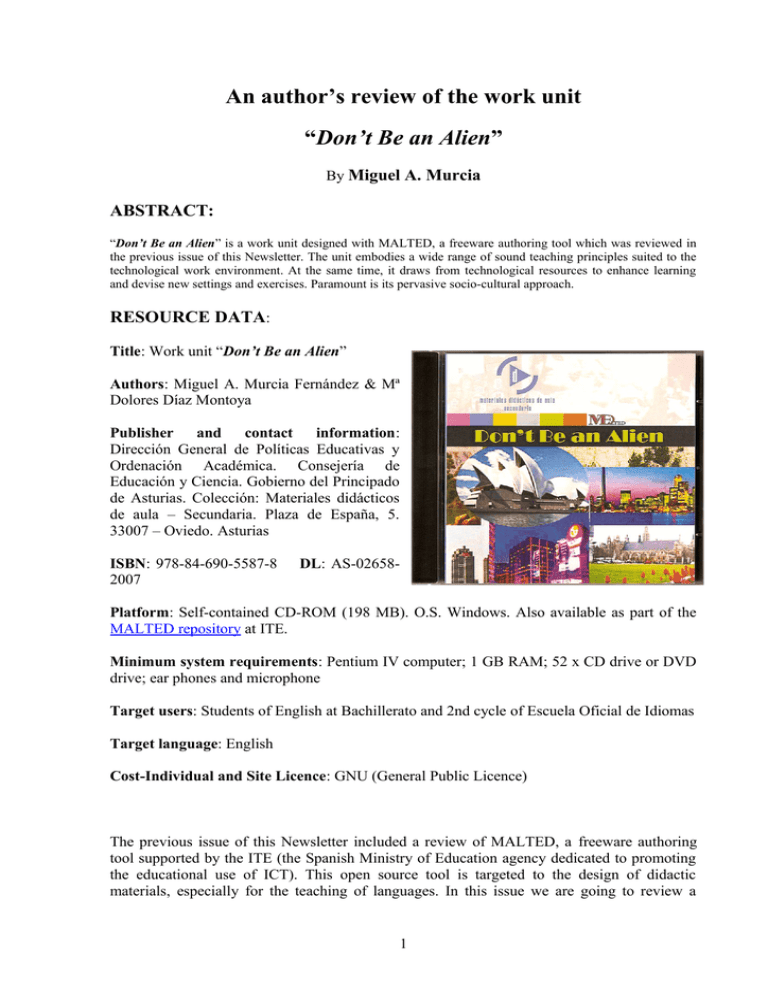
An author’s review of the work unit “Don’t Be an Alien” By Miguel A. Murcia ABSTRACT: “Don’t Be an Alien” is a work unit designed with MALTED, a freeware authoring tool which was reviewed in the previous issue of this Newsletter. The unit embodies a wide range of sound teaching principles suited to the technological work environment. At the same time, it draws from technological resources to enhance learning and devise new settings and exercises. Paramount is its pervasive socio-cultural approach. RESOURCE DATA: Title: Work unit “Don’t Be an Alien” Authors: Miguel A. Murcia Fernández & Mª Dolores Díaz Montoya Publisher and contact information: Dirección General de Políticas Educativas y Ordenación Académica. Consejería de Educación y Ciencia. Gobierno del Principado de Asturias. Colección: Materiales didácticos de aula – Secundaria. Plaza de España, 5. 33007 – Oviedo. Asturias ISBN: 978-84-690-5587-8 2007 DL: AS-02658- Platform: Self-contained CD-ROM (198 MB). O.S. Windows. Also available as part of the MALTED repository at ITE. Minimum system requirements: Pentium IV computer; 1 GB RAM; 52 x CD drive or DVD drive; ear phones and microphone Target users: Students of English at Bachillerato and 2nd cycle of Escuela Oficial de Idiomas Target language: English Cost-Individual and Site Licence: GNU (General Public Licence) The previous issue of this Newsletter included a review of MALTED, a freeware authoring tool supported by the ITE (the Spanish Ministry of Education agency dedicated to promoting the educational use of ICT). This open source tool is targeted to the design of didactic materials, especially for the teaching of languages. In this issue we are going to review a 1 specific resource designed with the latest version of the tool, the work unit “Don’t Be an Alien”. Originally published by the Consejería de Educación of the Asturian Principality as a self-contained CD, this teaching material is now also available for download from the official MALTED web site (http://recursostic.educacion.es/malted/web/curso.php? i id=13&sec=unidades) . Obviously, having this material in sight will greatly help to contextualize the commentary that follows ii. 1. Design principles of the work unit. These are some of the central principles that guided the design of the scenes which make up the unit. ■ First of all, special effort has been dedicated to making good use of multimedia languages. As a consequence, together with text we can see lots of images as well as quite a few audio recordings and videos. This allows for the reinforcement of linguistic messages and increases the chances of comprehension and interpretation, also opening room for students’ different learning styles. ■ Equally important has been the optimal use of the design resources provided by MALTED 3.0, especially for the simultaneous deployment of various channels (text, audio and video), different ways of interaction, the application of automatic resorts, and so on (see below). ■ Next, the computer is treated as an integral basis for complex work forms, where a great deal of utilities and open channels of communication (especially Internet services) coalesce. ■ From the point of view of teaching contents, a series of socio-cultural themes have been given a central role in structuring the work unit. It is not a common occurrence to see this important dimension of language to take this place, rather than grammar or specific situations, for instance, as the main point of reference. ■ From the field of learning psychology comes the idea of configuring the scenes in such a way as to cater for the perceptive habits of present day youths, typically socialized mainly in audio-visual environments, often times to the expense of reading practice. This does not imply just giving in to the dictatorship of images, but a new balance is sought, contrary to prevalent practices in traditional classrooms. Here, textual messages are short and backed up by means of audio-visual media. ■ Another key design criterion is the fostering of learner autonomy. Hence the unit’s scenes incorporate: (i) a clear statement of the task in hand, (ii) sources of reference (grammar explanations, skills development, a glossary, and so on), (iii) provision for the discretional use of help, (iv) different learning paths, etc. ■ There is provision for all major linguistic skills to be practised, oral production included. Assessment of oral production by means of speech recognition technologies is certainly a conspicuous gap in software development, which has yet to achieve effective practical application; short from that, here students are offered the chance to record and listen to their own production in a realistic context of interaction. ■ As is well known, motivation is a key aspect in learning. To foster it, several game-like contexts are included in this unit. 2 ■ ICT related methodologies are applied, such as webquests. ■ Last, but not least, the teacher is given a key role in guiding the students to exploit the learning materials and in helping them to make decisions. Therefore, plenty of extra optional resources are provided to expand work possibilities, following his/her own criteria. 2. Some old and new features in Malted 3.0. MALTED, the authoring instrument, is an interesting tool to be used for various reasons. In particular: ■ MALTED provides a design environment featuring a reasonably wide range of archive and media types, though limited to those accepted by the Java multimedia environment, which provides the technical platform for graphic presentation. ■ It embodies a relatively ample number of templates and integrated interactions which, when properly and creatively used, allow for the design of a wide range of exercises. ■ But beyond individual exercises, the system is aimed at the creation of complex, fully fledged units of work, like the one in hand, including the possibility of building into them diversified paths to cater for mixed-ability learning. ■ The many built-in actions make it easy to navigate through the unit and everything necessary for the user to interact with the scenes effectively. For instance, students value the quick response to their work in solving the exercises. Yet, for the full assessment of each student’s activity some extra worksheets must be provided, as MALTED lacks provision for tracing individual learners’ work. ■ The latest version features, together with a totally redesigned graphic editor, much simpler and more intuitive to use, the incorporation of auto-actions, that is to say, automatic resorts that react with fixed actions to certain events, such as entering a new frame, clicking on a given object, or the positive/negative checking of a task. All of these resorts and functionalities are widely exploited in the present unit. 3. A selection of work scenes. The selection of work scenes that are illustrated below try to orientate the teachers’ direct inspection of this material. Agreed, nothing can replace personal exploration and evaluation of the unit, least of all its application in real teaching situations, which is the true litmus test of any teaching device; but within the scope of the present review, at least they may point at some of the design trends that have been enunciated above. 3 From the beginning, the presence of socio-cultural contents is paramount. The unit refers the student to various sources of information and incorporates some computer resources, instructing the student in their use as work tools. Many exercises dealing with content comprehension are based on images, animations and videos. 4 Some popular songs connected with cultural topics are brought in as input for listening comprehension. Linguistic information is presented through a combination of textual, aural and visual channels to reinforce and diversify learning. The discrimination of different accents spoken in the major English-speaking countries is also dealt with as an aspect within the culture learning framework. 5 Feedback to students’ work is taken as a chance to provide expanded topic information through various channels (short texts, pictures and videos). The three preceding screen captures illustrate just as many game-like contexts –a crossword, a version of the ‘hangman’ game, and a simulation of a slot machine- to frame learning or evaluation activities. 6 Finally, this scene makes provision for eliciting oral production within a realistic simulation. The students’ speech is recorded and reproduced interspersed with pre-recorded sentences to simulate a ‘real’ conversation. All of these features and their teaching implications are fully described in a comprehensive, navigable Teacher’s didactic guide that completes this unit’s assets. 4. Classroom evaluation of the work unit. As mentioned above, the classroom supplies the final test of any teaching material. What follows are some extracts of the evaluation report provided by Avelino Coto Álvarez, an English teacher at IES “El Piles” (Gijón, Asturias), as part of the unit’s piloting requested before publication. "La unidad "Don't Be an Alien" ha proporcionado a los alumnos un amplio abanico de propuestas, pistas, métodos para fomentar el trabajo autónomo: glosarios, explicaciones, métodos de búsqueda y selección de información en la red, posibilidad de trabajar con programas de tratamiento oral en sus dos direcciones ordenador-alumno; y alumnoordenador. En algunos casos los alumnos también han aprendido a trabajar con un procesador de textos y a organizar carpetas y documentos, a utilizar criterios para una mejor selección de la información por medio de buscadores, etc. (…) Los alumnos han considerado este material como muy completo, que trata temas no revisados en los libros de texto, es original en su presentación por el uso de material multimedia (vídeos, canciones, tarjetas gráficas…). Han valorado como aspectos muy positivos: la variedad y diversidad de las actividades (comprensión auditiva, juegos, cuestionarios, etc.) y tareas (producción de textos escritos, grabaciones orales,…), los modos de interacción y la mayoritaria presencia de elementos motivadores (juegos, canciones, crucigramas, etc.) que según ellos alejan este material de los modelos “repetitivos” del aula normal. Los crucigramas, en concreto, les gustan por ser interactivos y proponer rutas, procedimientos y estrategias. Los adjetivos que los alumnos usan son “divertido”, “original”, “entretenido”, “actual”, “moderno”… De hecho, éstas han sido de las pocas sesiones donde he tenido que forzar a los alumnos a terminar la clase, pues querían más… (…) En general, a mi modo de ver, este tipo de unidades de uso autónomo y llenas de recursos multimedia, si bien, hoy por hoy, no pueden sustituir del todo a los recursos tradicionales, suponen un enorme paso adelante en el campo de la enseñanza, pues además 7 de despertar la motivación y la curiosidad de los alumnos, y de mantener su atención, sirven para aumentar las posibilidades de conectar con sus intereses, creando un espacio propio para el tan traído y llevado tratamiento de la diversidad. Los alumnos pasan de ser meros “receptores” de teorías y conceptos, de mantener un papel “pasivo”, a ser alumnos autónomos, a trabajar a su propio ritmo según sus competencias personales, a utilizar los recursos disponibles fomentando el desarrollo de esquemas de interpretación del entorno de la información en el que cada día más nos movemos en esta sociedad actual; a investigar, averiguar, descubrir y comprender, personalizando el aprendizaje y desarrollando los intereses y aptitudes de cada alumno y cimentando sus capacidades. (…)” 8 i If this unit is downloaded from the MALTED web site, the system will ask you to install the Java multimedia environment and the MALTED plug-in in your computer. Just follow the tips provided by the installation manager. Once the installation process is completed, the unit will be installed by default inside the folder C:\Malted\projects\. Next, the Malted Navigator must be launched by double-clicking on the ‘Malted_Navegador.exe’ icon, present inside the ‘C:\Malted\’ folder. Finally, select the work unit in the selection window for it to be displayed on the screen. Most of the MALTED Project resources, including this work unit, are also available for free distribution on a new DVD. Use the official application form in the MALTED web site. ii Failing that, a quick revision of this work unit’s main features can be obtained by consulting this two-part video presentation lodged in YouTube: http://www.youtube.com/watch?v=MpmjaUH0uzk and http://www.youtube.com/watch?v=661CCrHgL4o.
